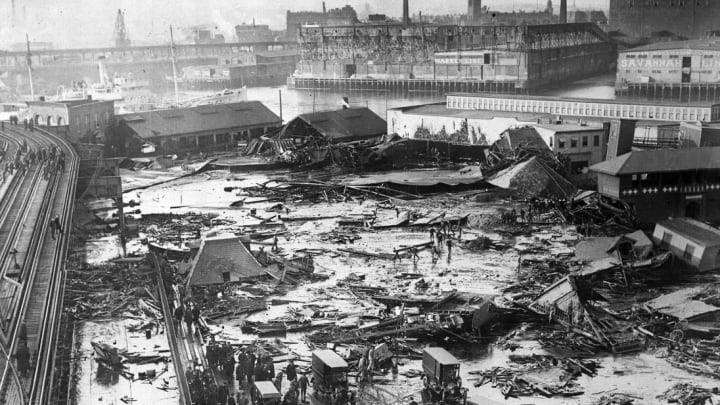On January 15, 1919, Boston suffered one of history’s strangest disasters: a devastating flood of molasses. The “Great Molasses Flood” tore through the city's North End and deposited so much gooey residue that locals claimed they could still smell the molasses on warm days decades later.
While most of us probably think of molasses as a tasty ingredient in treats like gingerbread, the sticky stuff has quite a few other uses. With a little know-how, one can turn molasses into rum or industrial alcohol fairly easily, and the Purity Distilling Company had built the gigantic tank in Boston’s North End in 1915 to supply its booze-making operations.
The steel tank was enormous: 50 feet tall, 90 feet across, and capable of holding 2.5 million gallons of molasses. (Although Prohibition kicked in with Nebraska’s ratification of the Eighteenth Amendment the very next day after the 1919 disaster, the United States Industrial Alcohol Company, Purity Distilling’s parent company, still had a license to distill alcohol for industrial applications.)

The massive tank was nearly full on January 15, thanks to a recent infusion of 2.3 million gallons of molasses from Puerto Rico. Just after noon, something went horribly wrong. Witnesses later recalled hearing a noise like gunfire as the tank’s rivets popped and the steel sides ripped open. Suddenly, 26 million pounds of molasses were tearing down Commercial Street in a 15-foot wave.
A shockingly destructive force

A giant wave of a sticky foodstuff sounds like something from a cartoon, but the surging molasses was a shockingly destructive force. The wave moved at upwards of 35 mph, and the power was sufficient to rip buildings off of their foundations. The molasses snapped the support girders from an elevated train track and smashed multiple houses. The Massachusetts Foundation for the Humanities’s website claimed the property damage alone totaled around $100 million in today’s dollars.
The human cost of the disaster was even more grim. The wave of molasses moved so quickly and so forcefully that anyone who was unlucky enough to be in its way didn’t stand much of a chance. They were either knocked over and crushed or drowned in the goo. The flood claimed 21 lives, and another 150 people suffered injuries. Any flood would have been disastrous, but the viscous nature of molasses made rescue attempts even trickier. Medics and police officers arrived on the scene quickly but had to slog through waist-deep goo to reach victims.
Even after the victims had been pulled from the muck, cleanup crews quickly learned that getting rid of 2 million gallons of molasses is no small task. In his book Dark Tide, Stephen Puleo wrote about one of the chief obstacles to the cleanup: firefighters couldn’t just use their hoses to blast the molasses off of buildings and streets with fresh water. Eventually they realized that saltwater would cut the hardened molasses and enable them to hose it down the streets into gutters. Thanks to all the foot traffic of rescue workers, cleanup crews, and rubberneckers, the sticky mess quickly moved around the city via people's shoes. In all, the cleanup effort required over 80,000 man-hours.
The Blame Game
How did this tragedy happen in the first place? The United States Industrial Alcohol Company was quick to blame everyone’s favorite early 20th-century scapegoats: anarchists. The company claimed that since its alcohol was an ingredient in government munitions, anarchists must have sabotaged the tank by detonating a bomb. Another theory explained that the molasses had fermented inside the tank, which led to an explosion.
Investigators soon found the real culprit, though: shoddy construction work. The company had been in such a hurry to get the tank built back in 1915 that it didn’t cut corners so much as it ignored the corners completely. Modern studies have found that the tank walls were both too thin and made of a steel that was too brittle to withstand the volume of molasses.
The man who oversaw the construction wasn’t an engineer or an architect; in fact, he couldn’t even read a blueprint. The tank needed to be an engineering marvel to hold all that weight, but the company never even consulted an engineer on the project. Basically, it threw up a gigantic tank as quickly and as cheaply as possible, skimped on inspections and safety tests, and hoped for the best.

In light of these details, it’s amazing that the tank held together for four years. Nearby residents reported that the tank had leaked since its construction. Rather than fix the problem, the United States Industrial Alcohol Company had painted the tank brown so the leaks would be less noticeable.
The largely working-class North End residents who had lost their homes and loved ones in the disaster predictably turned their rage toward the United States Industrial Alcohol Company. USIA soon found itself named as the defendant in 125 lawsuits, which led to a legal battle that nearly matched the flood’s scale.
The Massachusetts Superior Court named Colonel Hugh Ogden as the auditor who would hear the evidence and report back on the cause of the disaster. It took Ogden nearly six years to hear testimony from 3000 witnesses. When he finally penned his report, he concluded that there was no evidence to support the company’s theory of anarchist saboteurs. Instead, Ogden found that the “factor of safety” in the tank’s construction and inspection had been woefully low. USIA was liable for the damage and paid around $7000 to the family of each victim.
The Great Molasses Flood still seems like a tragedy that could have been averted, but the disaster really drew attention to the potential repercussions of shaky construction. The case helped prompt Massachusetts and many other states to pass laws requiring that engineers and architects inspect and approve plans for major construction projects.
A version of this story ran in 2019; it has been updated for 2022.
